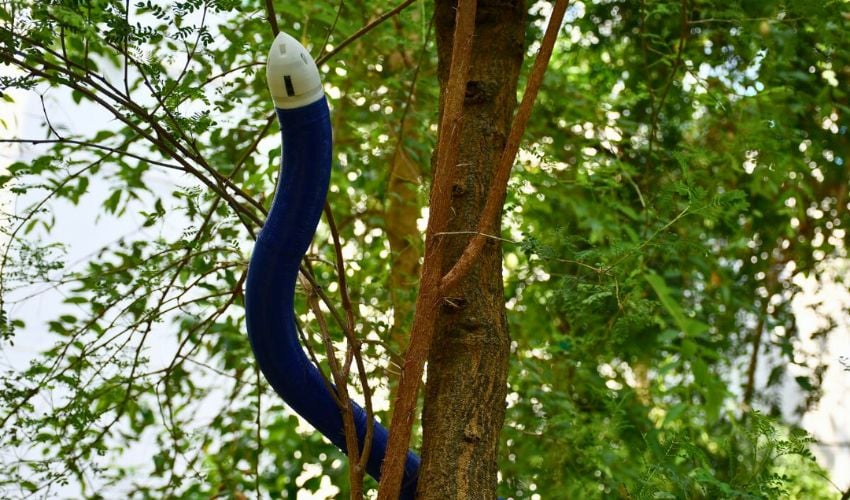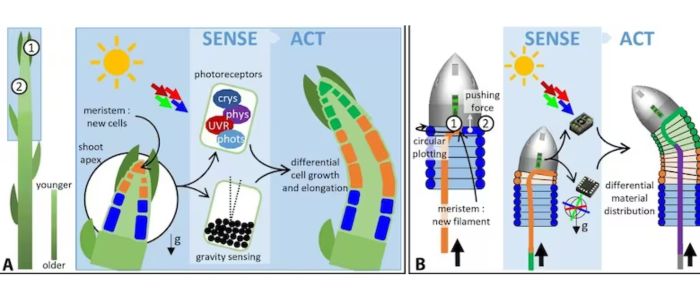FiloBot: The Robot Grows Like a Plant Using 3D Printing

The use of 3D printing in soft robotics has grown in recent years and is undoubtedly an important resource for researchers in the field, who exploit the possibilities of additive manufacturing to achieve results not otherwise achievable. Filobot is a new project combining biomimicry and 3D printing from the Italian Institute of Technology (IIT) in Genoa, Italy. It is a robot inspired by climbing plants that is capable of growing and “self-molding” in 3D.
Self-growing robots are an emerging solution in soft robotics for navigating, exploring and colonizing unstructured environments. However, their ability to grow and move in three-dimensional spaces, comparable to real-world conditions, is still under development. In this case, the study on Filobots, published in the journal Science Robotics, was conducted by the research group of Barbara Mazzolai, Associate Director for Robotics and head of IIT’s Bioinspired Soft Robotics lab.

FiloBot grows based on external stimuli (photo credits: IIT)
FiloBot, the 3D Printed Robot Inspired by Climbing Plants
This is not the first time we have talked about an innovative robotics project carried out at IIT Genoa. Last year we talked about I-Seed, the first robot inspired by a seed and made with 4D printing, whose function is to explore and monitor the ground above ground. Today, Filobot promises similarly viable applications. The robot was created as part of the European GrowBot project and is to date a prototype that has already shown enormous potential.
The inspiration for the IIT team came from observing nature, particularly climbing plants and vines. “To move from one point to another, plants must continually grow and adapt their bodies to external environmental conditions. In light of this observation, we understood how apical growth is an important prerequisite for expressing a form of movement and adaptation in robots as in plants,” commented Mazzolai and Emanuela Del Dottore, first author of the study.
Just like a climbing plant, the team wanted to make Filobot able to grow and adapt to the world around it. How? Through a 3D printing mechanism embedded in the robot, combined with motion sensors.
The robot has a rotating head that deposits a thermoplastic filament (using an FDM process), which then goes to lengthen its body. The remarkable aspect of Filobot is its ability to grow by depositing filament based on external stimuli, including gravity, light and shade. Thus exhibiting adaptive behavior comparable to the tropism of real plants. Seeing it in action, it really looks like a living body.
FiloBot’s complex mechanism allows it to grow in relation to gaps, potential supports and pathways in complex habitats. FiloBot never grows in the same way, but takes on a different configuration each time depending on its environment. Thanks to these characteristics, it can be used for numerous applications, first and foremost environmental monitoring: measuring pollution in hazardous areas, exploring hard-to-reach or unknown natural environments.
An innovation that, while it still needs to be tested and fine-tuned, represents a major milestone in the union of biomimicry and robotics and a huge step forward in environmental protection. We look forward to seeing what it may become in the near future. You can get more information from the study HERE.
What do you think of FiloBot? Let us know in a comment below or on our LinkedIn, Facebook, and Twitter pages! Don’t forget to sign up for our free weekly newsletter here, the latest 3D printing news straight to your inbox! You can also find all our videos on our YouTube channel.
*Cover Photo Credits: Istituto Italiano di Tecnologia (IIT), Genova






